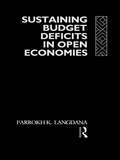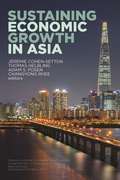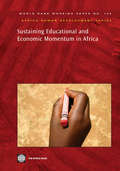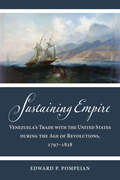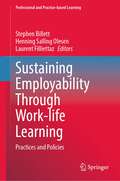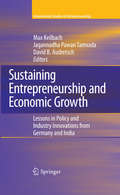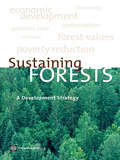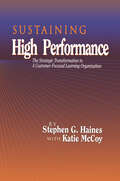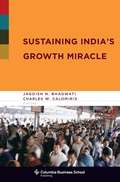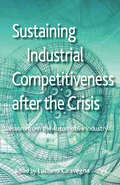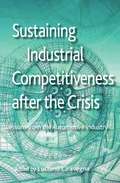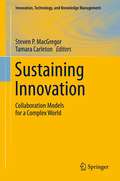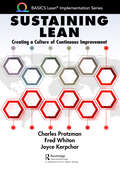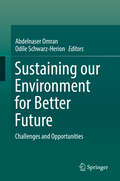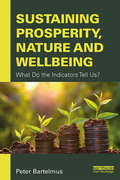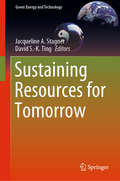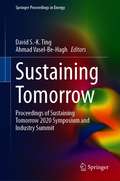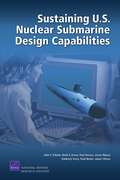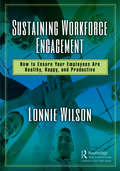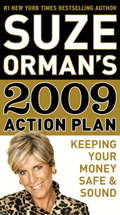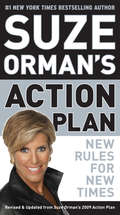- Table View
- List View
Sustaining Domestic Budget Deficits in Open Economies
by Farrokh LangdanaIn recent times the US economy has been characterised by burgeoning budget and current account deficits and increasing amounts of foreign capital inflows. For the UK too, the budget deficit remains a central weakness in the economy. In the light of these problems this book presents a consistent economic framework for analysing the effects and impli
Sustaining Economic Growth in Asia
by Jérémie Cohen-Setton Thomas Helbling Adam S. Posen editorsEconomic growth, inflation, and interest rates have declined in Asia, just as they have in the United States and Europe. Sustaining Economic Growth in Asia explores the relevance to several Asian economies of the diagnosis known as “secular stagnation.” Leading experts on the region discuss the fiscal and monetary policy challenges of reviving growth without generating domestic financial imbalances. The essays on innovation, demographics, spillovers, and various policy proposals are accompanied by case studies focusing on Japan, South Korea, China, India, and Indonesia.
Sustaining Educational and Economic Momentum in Africa
by The World BankForty-four African ministers of finance and of education from 28 countries met in Tunis at a July 2009 conference on "Sustaining the Education and Economic Momentum in Africa amidst the Current Global Financial Crisis." The conference attendees discussed why and how they must exercise joint political leadership during the current global economic crisis to protect the educational development achieved during the past decade. They acknowledged that educational reform is an agenda for the entire government and that strong leadership to foster cross-ministry collaboration, coordination, and mutual accountability is required to ensure that education and training investments are effective in advancing national development and economic progress.
Sustaining Empire: Venezuela's Trade with the United States during the Age of Revolutions, 1797–1828 (Studies in Early American Economy and Society from the Library Company of Philadelphia)
by Edward P. PompeianWhy did trade with the United States prolong Spanish colonial rule during the Venezuelan independence struggles?From 1790 to 1815, much of the Atlantic World was roiled by European imperial wars. While the citizens of the United States profited from the waste of blood and treasure, Spanish American colonists struggled to preserve their prosperity on an imperial periphery. Along the Caribbean coast of South America, colonial elites and officials fought to secure Venezuela from threats of foreign invasion, slave rebellion, and revolution. For these elites, trading with the United States and other neutral nations was not a way to subvert colonial rule but to safeguard the prosperity and happiness of loyal subjects of the Spanish Crown. Food insecurity, deprivation, and political uncertainty left Venezuela vulnerable to revolution, however.In Sustaining Empire, Edward P. Pompeian lets readers see liberal free trade just as colonial Venezuelans did. From the vantage point of the slave-holding elite to which revolutionary figures like Simón Bolívar belonged, neutral commerce was a valuable and effectual way to conserve the colonial status quo. But after Spain's crisis of sovereignty in 1808, it proved an impediment to Venezuelan independence. Analyzing the diplomatic and economic linkages between the new US republic and revolutionary Latin American governments, Pompeian reminds us that the United States did not, and does not, exist in a vacuum, and that the historic relationships between nations mattered then and matters now.Examining an overlooked region, Pompeian offers a novel interpretation of early United States relations with Latin America, showing how US merchants executed government contracts and established flour, tobacco, and slave trading monopolies that facilitated the maintenance of colonial rule and the Spanish Empire. Trading with the United States, Pompeian argues, kept both colony and empire under a tenuous hold despite revolutionary circumstances. A fascinating revisionist history, Sustaining Empire challenges long-standing assertions that this commerce served primarily as a vector for the one-way transmission of revolutionary, liberal ideas from the North to South Atlantic.
Sustaining Employability Through Work-life Learning: Practices and Policies (Professional and Practice-based Learning #35)
by Stephen Billett Henning Salling Olesen Laurent FilliettazThis book seeks to advance understandings of and approaches to supporting and sustaining working age adults’ learning across lengthening working lives and inevitable transitions they encounter and are required to negotiate. It is founded on the processes and findings of a three-phase practical inquiry into worklife learning and its implications for workplace and educations’ practice conducted in Australia over a three-year period commencing in 2019. Diverse perspectives and orientations were utilised in approaches to data analysis and renderings from the data, thereby opening up the analysis of these complex phenomena to different lines of interrogation, questions and analytical approaches. It elaborates more fully understandings about the processes of adults’ learning and development across their lifespan of adulthood referred to as working life, and what factors and contributions supported that learning. This book also attempts to reconcile a coherent view about development across the work lifespan, and how that can be supported by education provisions, workplaces, communities, and by the adults themselves.
Sustaining Entrepreneurship and Economic Growth
by Jagannadha Pawan Tamvada David B. Audretsch Max KeilbachAcademic research on developed countries has scientifically evaluated the role of entrepreneurship on economic growth, market expansion, commercializing innovation, and reducing unemployment. In this research, regions or industries with higher rates of entrepreneurship show higher levels of innovation and economic growth. The literature on entrepreneurship and innovation has largely ignored developing countries, despite the positive results from new venture investments in India, China, and elsewhere. This volume bridges this gap by bringing together research by scholars in Germany and India, whose analysis of entrepreneurship, innovation, and economic development in their respective countries reveals commonalities. Covering such timely issues as R&D and labor policies and including case examples from the chemical, biotech, and IT industries, the authors offer insight into the entrepreneurial process. The volume concludes with a discussion of the global implications for entrepreneurship research and policy.
Sustaining Forests: A Development Strategy
by World BankThe World Bank's Forests Strategy, adopted in October 2002, charts a path for the Bank's proactive engagement in the sector to help attain the goal of poverty reduction without jeopardizing the environmental values intrinsic to sustainability. This strategy replaces the Bank's 1991 Forestry Strategy, and was developed on the basis of the findings of an independent review of the 1991 strategy and a two-year consultative process with development partners and stakeholders around the world. The revised strategy, Sustaining Forests, is built on three guiding pillars: harnessing the potential of forests to reduce poverty, integrating forests into sustainable economic development, and protecting global forest values. Recognizing the key role forests play in contributing to the livelihoods of people living in extreme poverty, government and local ownership of forest policies and interventions are emphasized along with the development of appropriate institutions to ensure good governance and the mainstreaming of forests into national development planning. The strategy also aims to support ecologically, socially and economically sound management of production forests by ensuring good management practices through application of safeguard procedures and independent monitoring and certification. Implementation of the strategy will center on building and strengthening partnerships with the private sector, non-governmental organizations, and other donor agencies to promote better forest conservation and management at country and global levels.
SUSTAINING High Performance: The Strategic Transformation to A Customer-Focused Learning Organization
by Stephen HainesIn an attempt to achieve high levels of growth, profit, and competitive advantage, American businesses have been implementing a variety of management initiatives, such as TQM, reengineering, service management, self-directed work teams, and empowerment. Too often, these initiatives, when implemented individually, fail or provide only short-term results. American industry is now realizing that no single initiative can provide an overall, long-term solution. A more comprehensive, integrated approach is necessary to sustain future success. Sustaining High Performance shows you how to develop and implement an integrative "systems-thinking" strategy that will ensure a successful long-term management plan.Sustaining High Performance will help you reinvent your strategic management system (planning and change) for the 21st century and give you the tools and information to pull ahead of the competition and become a powerhouse organization.
Sustaining India's Growth Miracle (Columbia Business School Publishing)
by Charles Calomiris Jagdish BhagwatiThe economy of India is growing at a rate of 8 percent per year, and its exports of goods and services have more than doubled in the past three years. Considering these trends, economists, scholars, and political leaders across the globe are beginning to wonder whether India's growth can be sustained.The contributors to this volume analyze the forces behind India's emerging role as a world economic player and identify the hidden weaknesses that, if unaddressed, may slow the country's growth. Chapters suggest how to transform India's primarily rural population into a gainfully employed modern sector; methods to achieve fiscal sustainability and consolidation; infrastructure bottlenecks, especially in terms of finite energy resources; and, given the country's complex electoral government and global political position, the obstacles toward effecting policy reform. Sustaining India's Growth Miracle is a valuable resource for practitioners, policymakers, students, and scholars. It tackles issues from political, economic, and academic perspectives, and the concluding chapter, a talk given by the commerce and industry minister of India, discusses the country's position as a world power, outlining several reasons for its success and exploring the difficulties that lie ahead.
Sustaining Industrial Competitiveness after the Crisis: Lessons from the Automotive Industry
by L. CiravegnaAdopting a multi-disciplinary approach and using the case of the automotive industry as a starting point this volume discusses how industrial companies can remain competitive in spite of the current economic downturn.
Sustaining Industrial Competitiveness after the Crisis
by Luciano CiravegnaAdopting a multi-disciplinary approach and using the case of the automotive industry as a starting point this volume discusses how industrial companies can remain competitive in spite of the current economic downturn.
Sustaining Innovation
by Steven P Macgregor Tamara CarletonIn many ways, the process of innovation is a constant social dance, where the best dancers thrive by adapting new steps with multiple partners. The systematic and continuous generation of value in any innovation system relies on collaboration between different groups, who must overcome multiple, often competing agendas and needs to work together fruitfully over the long term. Featuring contributions from leading researchers, business leaders, and policymakers representing North America, Europe, India, Africa, and Australasia, this volume investigates different combinations of collaborative arrangements among innovation actors, many of which are changing conventional expectations of institutional relationships. Collectively, the authors demonstrate that no particular combination has emerged as the most dominant, or even resilient, model of innovation. Several authors expand on our understanding of the triple helix model, with both academics and practitioners looking to the quadruple helix (encompassing business, academic, government, and civil society) as the new standard. Other authors address aspects of open innovation, co-creation, and user-centered design--all testaments to the rapidly shifting landscape. At the same time, many businesses, academics, and governments, not to mention non-profit organizations, foundations, and society at large, are active in conversations about how to pursue a more sustainable model of innovation. The pursuit of this holy grail of innovation is both facilitated and complicated by an ever-accelerating technological environment in which social networking and mobile tools are emerging as new dance arenas.
Sustaining Key Skills in the UK Military Aircraft Industry
by Tony Starkey Nigel Edgington Hans Pung Matt Bassford Kristin WeedThe United Kingdom Ministry of Defence's Fixed Wing Sector Strategy Board commissioned RAND Europe to assist in the development of a strategy and sustainment plan for the military fixed wing sector. RAND focused on the health and sustainment of key skills in the sector's industrial base. This monograph describes the qualitative and quantitative methodologies that the RAND team followed and summarises its findings and recommendations.
Sustaining Lean: Creating a Culture of Continuous Improvement (BASICS Lean® Implementation)
by Charles Protzman Fred Whiton Joyce KerpcharLean is about building and improving stable and predictable systems and processes to deliver to customers high-quality products/services on time by engaging everyone in the organization. Combined with this, organizations need to create an environment of respect for people and continuous learning. It’s all about people. People create the product or service, drive innovation, and create systems and processes, and with leadership buy-in and accountability to ensure sustainment with this philosophy, employees will be committed to the organization as they learn and grow personally and professionally. Lean is a term that describes a way of thinking about and managing companies as an enterprise. Becoming Lean requires the following: the continual pursuit to identify and eliminate waste; the establishment of efficient flow of both information and process; and an unwavering top-level commitment. The concept of continuous improvement applies to any process in any industry. Based on the contents of The Lean Practitioners Field Book, the purpose of this series is to show, in detail, how any process can be improved utilizing a combination of tasks and people tools and introduces the BASICS Lean® concept. The books are designed for all levels of Lean practitioners and introduces proven tools for analysis and implementation that go beyond the traditional point kaizen event. Each book can be used as a stand-alone volume or used in combination with other titles based on specific needs. Each book is chock-full of case studies and stories from the authors’ own experiences in training organizations that have started or are continuing their Lean journey of continuous improvement. Contents include valuable lessons learned and each chapter concludes with questions pertaining to the focus of the chapter. Numerous photographs enrich and illustrate specific tools used in Lean methodology. Sustaining Lean: Creating a Culture of Continuous Improvement focuses on standard work audits, training, Lean Practitioner certification, Hoshin planning, Lean Leadership, and how to run effective meetings. The authors discuss the cultural transformation which must occur to create a Lean culture by understanding what the components are in this culture. The importance of training and the value of the person are also discussed, as is what it takes to be a Lean leader.
Sustaining our Environment for Better Future: Challenges and Opportunities
by Abdelnaser Omran Odile Schwarz-HerionThis book covers a variety of topics regarding environmental practices in our day-to-day lives, as well as topics concerning sustainable development as a broader concept embracing ecological, social, and economic aspects to improve the quality of life for people around the world. Starting with the traditional controversy between the neoclassical economy and sustainable economy, which may be overcome by scientific progress due to more intensive scientific studies of the sustainability paradigm, the book proceeds to discuss various problems and challenges regarding environmental protection and sustainable development in different countries and on different continents. This includes analyses of recent, sometimes fatal mining disasters in South and North America, challenges and opportunities for rural development in Africa and Australia, an exploration of the role of women for sustainable development in Palestine, water safety and water security issues in Asia and Australia, the environmental exploitation of popular tourism destinations like Acapulco, and deforestation in Malaysia, suggesting innovative approaches to turn challenges into opportunities to effectively tackle these problems. Other topics addressed involve sustainable energy creation for future generations, a research survey among Romanian students on sustainable consumption behavior, validity testing for a heat transfer model in a greenhouse, and a case study on sustainability risk management practices at Malaysia’s environmentally sensitive companies. The book closes with an examination of highly digitalized Smart Cities as a potentially valuable complement to conventional urban and rural lifestyles in connection with achieving the UN Sustainable Development Goals (SDGs).
Sustaining Prosperity, Nature and Wellbeing: What do the Indicators Tell Us?
by Peter L.P. BartelmusThis book explores what is needed for an overall evaluation of the prosperity and wellbeing of people within a framework of sustaining the economy, environment and development. The book begins by assessing the validity of available data, indicators and indices in decision and policy making. It describes what the data tell us about the effects of economic activity on the quality of life and prosperity of people and nations, now and in the future, and highlights how a reliance on partial and distorted information can thwart rational policies. It also examines whether less tangible notions of wellbeing and happiness lend themselves to quantification and prediction. Overall, Bartelmus demonstrates the need for integrated accounting and analysis to revise policy priorities around environmental, social, economic and sustainability concerns. Confronting the persisting polarization of environmentalists and economists, this book will be of great relevance to students, scholars and professionals with an interest in environmental and ecological economics, sustainability indicators and their use in integrative policy.
Sustaining Resources for Tomorrow (Green Energy and Technology)
by Jacqueline A. Stagner David S.-K. TingThis book reflects the current state of knowledge on sustainability in a wide range of fields, from engineering to agriculture, to education. Though primarily intended to offer an update for experts and researchers in the field, it can also be used as a valuable educational tool for relevant undergraduate and graduate courses. Key aspects covered include the better and more responsible engineering and management of energy conversion processes, the development of renewable energy technologies, and improvements in conventional energy utilization and food production. In addition, the book addresses green buildings, the green economy, waste and recycling, water, ecopolitics and social sustainability.
Sustaining Superior Performance: Commitments and Capabilities
by Gary P. Pisano Pankaj GhemawatPresents evidence on the unsustainability of many competitive advantages, reviews the typical threats to the sustainability, and discusses ways in which those threats can be combatted.
Sustaining Superior Profits: Customer and Supplier Relationships
by Anita M. McgahanExplains relationships between asset specificity, holdup, and vertical integration. In particular, it emphasizes solutions to the holdup problem through vertical integration and contracting.
Sustaining Tomorrow: Proceedings of Sustaining Tomorrow 2020 Symposium and Industry Summit (Springer Proceedings in Energy)
by David S.-K. Ting Ahmad Vasel-Be-HaghThis book includes the proceedings of the Sustaining Tomorrow 2020 symposium and summit which bring together research from experts in academia, industry, and policy arenas to uncover the challenges and to forge solutions to sustain tomorrow. To sustain tomorrow, we need to continuously make headway in Agriculture, Engineering, Energy, Environment, Economics, Water, among other necessities. This book disseminates the most recent advances in these fields and promotes collaborations to maximize opportunities for innovative solutions.Though primarily intended to offer an update for experts and researchers in the field, this book is equally useful as a valuable educational tool for relevant undergraduate and graduate courses. Key aspects covered include the better and more responsible engineering and management of energy conversion and conservation processes, the furthering of renewable energy technologies, improvements in water-agriculture nexus and energy-environment-economics relationship, and endorsing education, implementation, and evaluation of all-embracing sustainability.
Sustaining U.S. Nuclear Submarine Design Capabilities
by Jessie Riposo Paul Deluca John F. Schank Mark V. Arena Kimberly Curry HallNuclear submarine design resources at the shipyards, their suppliers, and the Navy may erode for lack of demand. Analysis of alternative workforce and workload management options suggests that the U.S. Navy should stretch out the design of the next submarine class and start it early or sustain design resources above the current demand, so that the next class may be designed on time, on budget, and with low risk.
Sustaining Value
by Robert J. DolanDescribes the challenges a firm faces in building and sustaining a value proposition over time. Describes major ways in which the marketing environment changes over time and the methods a firm can use to protect its market position.
Sustaining Workforce Engagement: How to Ensure Your Employees Are Healthy, Happy, and Productive
by Lonnie WilsonThis book explains the importance of employee engagement – It defines what it is, what it will do for your business, and how you can achieve it as well as sustain it. It covers the history of employee engagement along with why employees were formerly much more engaged with their work and company than they are currently. The author explains, in depth, why employees want to be engaged but are not. He discusses the emotional, psychological and social forces that make engagement, the state that people naturally and continually attempt to achieve. Furthermore, he makes a compelling case that engagement is not only natural, but, when achieved, it also creates a happy and productive workforce where employees are not only emotionally but also physically more healthy. You will learn exactly how a business can not only cause this engagement to surface, but also how to sustain it. He presents a complete discussion of the "basics and beyond" that are required to support a system of engagement. He explains engagement as a system and how to interpret and utilize a system diagram using the "high leverage points" to further fuel and sustain engagement. The book then provides a critical and comprehensive series of discussions of precisely what management must do to unlock the power of a fully engaged workforce. In addition to learning how to measure engagement, there are detailed discussions, along with two confirming case studies, of how to improve your levels of engagement. Essentially, the author examines engagement from top to bottom integrating the theories of the scholars, with the experiences of the practitioners. In so doing he can explain, in simple terms, how engagement can be achieved and why people try so hard to create a fully engaged workforce with both the best of intentions and a true passion to achieve it … yet fall short. There is a simple reason -- achieving engagement is all about management and the many changes that must be made, and that raises the crucial question: Is management both willing and able to recognize, accept, and execute the needed paradigm shifts? The stark reality is that the changes that must first occur are in the thoughts, beliefs, and actions of the management team. This book gives you a path to follow that may achieve just that. And the remaining question for the senior management is: What are you prepared to do? The mystery of achieving engagement is known, the science is known, the answers are not technically complicated, and now it comes down to a simple choice: Are you or are you not willing to change? And with that choice, there are resultant consequences. It is no more complicated than that.
Suze Orman's 2009 Action Plan
by Suze Orman2009: The Year You Can't Afford to Make Any Mistakes with Your Money.The credit crunch, the stock market freefall, the staggering toll of home foreclosures and job losses: The economic crisis that struck in 2008 has left no one untouched and everybody reeling. Seemingly overnight, the financial landscape has undergone seismic changes that suddenly have you asking all kinds of questions: Are your savings safe? Should you continue to invest in your retirement account? Should you keep your home if it's worth less than what you owe or should you sell it? How do you pay your bills if you've just been laid off?The nation's go-to expert on financial matters, Suze Orman, believes that 2009 is a critical year for your money. There are safeguards to put in place, actions to take, costly mistakes to avoid, and even opportunities to be had, so that you are protected during the bad times and prepared to prosper when things take a turn for the better. No matter what situation you're in, you will find a plan of action and the answers to your questions about:* Credit * Retirement*Savings and Spending*Real Estate*Paying for College* Protecting Your FamilySUZE ORMAN'S 2009 ACTION PLAN delivers honest, straightforward guidance--what to do, when to do it, and how to do it--as only Suze Orman can.From the Trade Paperback edition.
Suze Orman’s Action Plan: Revised and updated from Suze Orman’s 2009 Action Plan
by Suze OrmanTimes have changed and the rules have changed, but financial security is still the goal. Do you know how to get there? There is a new reality out there--a new normal. What was once certain--that you would be able to retire comfortably, that you would pay for your kids' education, that your home would appreciate in value--is no longer a sure thing. So much has changed on the financial landscape that it's hard to know which moves are the right ones to make. Suze Orman's million-copy bestselling financial action plan--fully revised and updated for 2010 and beyond--will show you the way. NEW TIMES CALL FOR NEW RULES--AND THIS IS WHAT SUZE ORMAN'S ACTION PLAN DELIVERS: * up-to-date information on new legislation that could affect how you will achieve your financial goals* an explanation of new FICO practices, and a new strategy for dealing with credit card debt* sound advice about rebuidling your retirement plan, and what to do if you're already retired* guidance on how to live within your means, and strategies to keep you on the path to achieving your goals in this new age of financial honesty PLUS AN ALL-NEW CHAPTER ON KIDS AND MONEY--how to give your kids a solid financial education, no matter their age! Download Suze Orman's free Money Tool iPhone applicaton in the iTunes store.From the Paperback edition.
